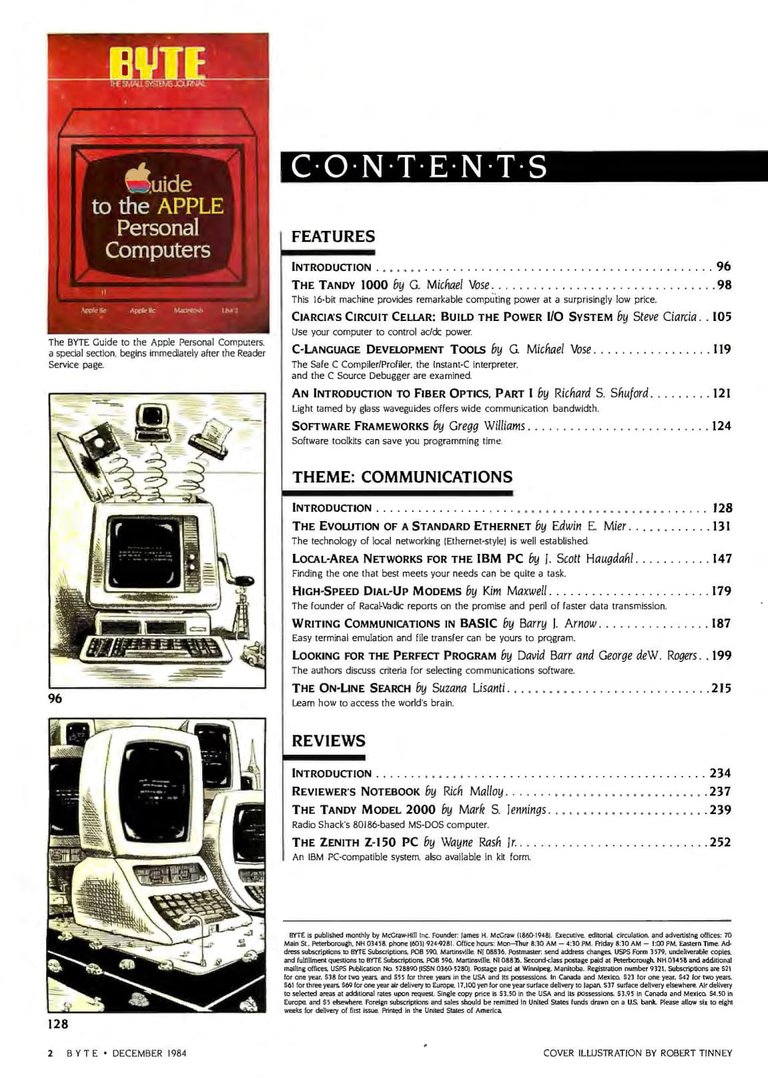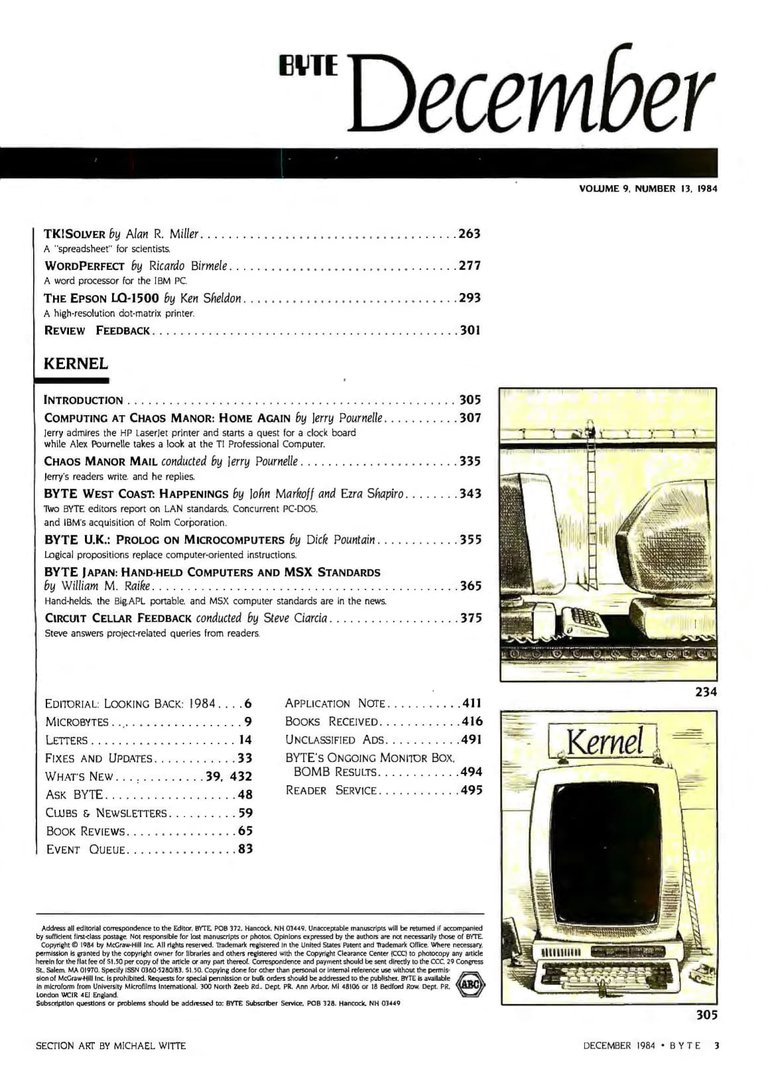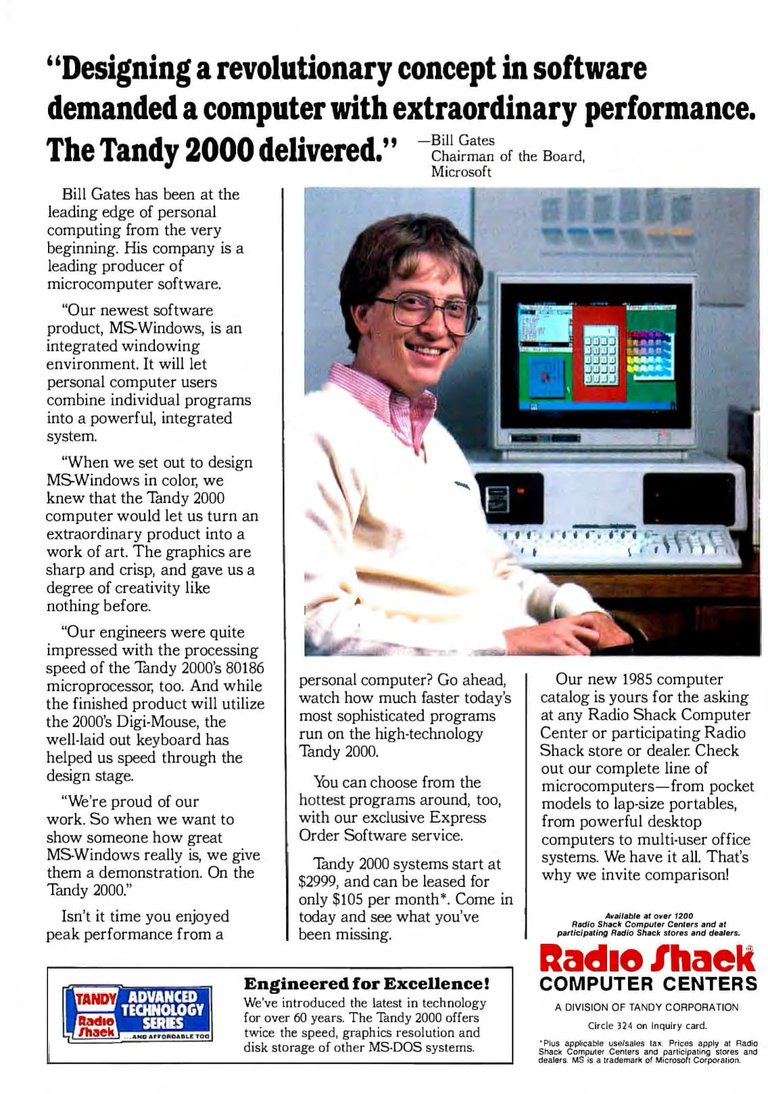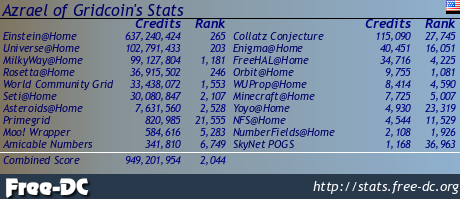Byte (December 1984)

Cover of the December 1984 issue of Byte
In 1984, Byte covered personal computers and other small systems that were availabe at the time. Some issues of Byte could almost compete with the phone book sized Computer Shopper that came along later. The December 1984 issue weighs in at 672 pages and includes:
Features
- The Tandy 1000 - The Tandy 1000 was released after the Tandy 2000. It was meant to be a lower cost IBM PC clone. Something that would compete more with the PCjr. Minimum configuration included a 4.77 MHz 8088 CPU, 128KB RAM, a single 360K 5.25" disk drive and a monochrome monitor for $1358.95 or $1199 without monitor. Additional options included a second floppy drive for $299.95, an internal 300bps modem for $179.95, an RS-232C interface for $99.95, a 128K memory expansion board, and a color monitor for $549.95.
- Ciarcia's Circuit Cellar: Build The Power I/O System - Instructions for building the hardware needed to use a computer to control power to items in your house.
- C-Language Development Tools - A brief look at some recent new C Language tools including the Safe C Compiler/Profiler, Instant-C, and C Source Debugger.

Table of Contents from the December 1984 issue of Byte
Theme: Communications
- The Evolution of a Standard Ethernet - Networking today is a lot easier than it used to be. The first Ethernet hardware was developed by Xerox in the late 1970s. However, in those early days and for a long time, Ethernet made use of coaxial cable and transceivers and repeaters. It was much harder to setup, much more expensive, and much slower than today.
- Local-Area Networks for the IBM PC - There were many options for local area networking for the IBM PC. However, they were for the most part not compatible with each other and tended to be fairly expensive. The features offered by 40 different vendors are summarized here with speeds from 375Kbps to 10Mbps, using twisted-pair, coax or fiber, and using a variety of protocols including Arcnet, Ethernet, CSMA, token passing, and various proprietary schemes.
- High-Speed Dial-Up Modems - The vast majority of consumer modems in 1984 were either 300bps or 1200bps. 2400, 4800, and 9600bps modems existed but were very expensive. A 4800bps modem would set you back $2500, 2400bps $800-$1400, 1200bps $450-$700 and a $300bps modem a much more affordable $60-$350.
- Writing Communications in BASIC - Using BASIC to implement a terminal emulator and file transfer capabilities.
Reviews
- The Tandy Model 2000 - The Tandy 2000 was released before the Tandy 1000 and is the higher end machine. However, it sacrificed some PC compatibility for performance. Some regular DOS programs would work fine while others did not. Tandy also released special versions of some commercial software enhanced for the Tandy 2000. The Tandy 2000 featured an 80186 CPU @ 8MHz, 128KB of RAM (expandable to 768KB), dual 5.25" floppy disk drives, and a monochrome monitor for $3000. A version with one floppy drive and a 10MB hard drive cost $4500.
- The Zenith Z-150 PC - The specs of this IBM clone very closely match the original. It includes an 8088 CPU @ 4.77MHz, two 360K 5.25" disk drives, and 320KB of RAM. The most interesting things about it is that it uses a backplane instead of a motherboard and it is available in kit format. A long time ago (probably circa 1995), I had a very similar machine. I think it was a slightly newer version but the case looked identical.
- TK!Solver - An application for scientists and engineers for solving general mathematical expressions.

Table of Contents from the December 1984 issue of Byte (continued)
Kernel
- Computing at Chaos Manner: Home Again - Adventure in repairing a Zorro Z-100, some info on laser printers, BASIC compatibility on the Zenith Z-150, shopping for a clock/calendar board, The TI Professional computer, and more.
- Byte West Coast: Happenings - IBM acquires Rolm Corp., IBM to offer local-area network configurations for its personal computers, Concurrent PC-DOS 3.2 released by Digital Research, and more.
- Byte U.K.: Prolog on Microcomputers - An overview of Micro-PROLOG for DOS and CP/M.
- Byte Japan: Hand-Held Computers and MSX Standards - A brief look at new handheld computers in Japan including the Epson HC-88/-80 and the Ampere Big.APL. Plus, an overview of the MSX standard and a brief look at several machines including the Canon V-10 and V-20, Victor AV, Toshiba HX-10S and HX-10D, Pioneer PALCOM PX-7, Sony "Hit Bit" HD-55 and HD-75, Hitachi HI, Yamaha Y1S503, Fujitsu FM-X, Mitsubishi ML-F120, and Matsushita CF-2000 and CF-3000.
- Circuit Cellar Feedback - Readers chime in about the new 65816 chip, digitizing stamps, MPX-16 keyboard interface, and more.
- Editorial: Looking Back: 1984 - Highlights of 1984 include the introduction of the IBM PCjr, IBM PC AT, Hewlett Packard 150, Tandy 2000, Tandy 1000, Apple IIc, AT&T PC, Compaq Deskpro, Corona Mega PC, NEC APC III, and lots more.

Back cover of the December 1984 issue of Byte
Read more: https://www.megalextoria.com/wordpress/index.php/2024/02/27/byte-december-1984/
Check out my other Social Media haunts (though most content is links to stuff I posted on Hive or reposts of stuff originally posted on Hive):
Wordpress: https://www.megalextoria.com/wordpress
Tumblr: https://www.tumblr.com/blog/darth-azrael
Twitter: https://twitter.com/Darth_Azrael
Blogger: https://megalextoria.blogspot.com/
Odyssee: https://odysee.com/@Megalextoria:b
Rumble: https://rumble.com/c/c-2385054
Daily Motion: https://www.dailymotion.com/Megalextoria
Books I am reading or have recently read:
The Old Curiosity Shop by Charles Dickens
The Templars by Dan Jones
Republic of Thieves by Scott Lynch

Absolutely holy cow. And this is something that would have been phenomenally expensive back then for the average individuals. However holy cow...
Excellent post!
Computers could be incredibly expensive in the 1980s. Especially more business oriented ones like the PC and its clones. Adjusted for inflation, those prices are a lot bigger too.
Yep the glut of the computer market continues to drive prices down.
https://inleo.io/threads/darth-azrael/re-darth-azrael-2gu8ydkex
The rewards earned on this comment will go directly to the people ( darth-azrael ) sharing the post on LeoThreads,LikeTu,dBuzz.